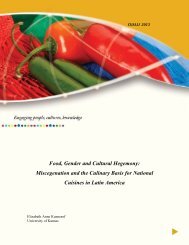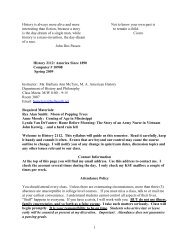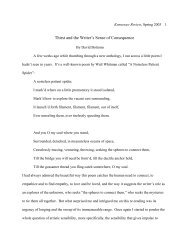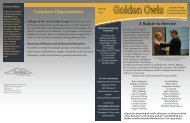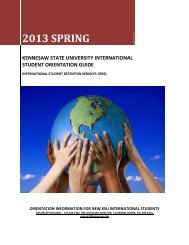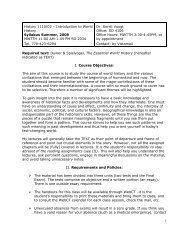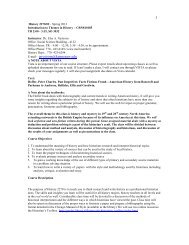Beyond Rosie: Women in World War II - Kennesaw State University
Beyond Rosie: Women in World War II - Kennesaw State University
Beyond Rosie: Women in World War II - Kennesaw State University
Create successful ePaper yourself
Turn your PDF publications into a flip-book with our unique Google optimized e-Paper software.
<strong>Beyond</strong> <strong>Rosie</strong>: <strong>Women</strong> <strong>in</strong> <strong>World</strong> <strong>War</strong> <strong>II</strong><br />
Source Sheet 16<br />
E x c e r p t: Several Madnesses Are Born: Work<strong>in</strong>g-Class <strong>Women</strong><br />
d u r i n g the 1930s and <strong>World</strong> <strong>War</strong> <strong>II</strong><br />
For work<strong>in</strong>g-class women prior to <strong>World</strong> <strong>War</strong> <strong>II</strong>, marriage to a union man represented<br />
a positive step <strong>in</strong> status. Daughters of a union member, both Jewel Bretel and<br />
her sister Charlene Goodman believed their husbands’ union cards provided them with<br />
a degree of security and respectability. Wallace Goodman, Charlene’s husband, even<br />
claimed that his father-<strong>in</strong>-law <strong>in</strong>sisted that he jo<strong>in</strong> the Carpenters’ Union when he married<br />
her.<br />
This status and security became more available to women directly dur<strong>in</strong>g <strong>World</strong> <strong>War</strong><br />
<strong>II</strong>. As a result of the <strong>in</strong>crease <strong>in</strong> woman members, the AFL, the CIO, and <strong>in</strong>dependent<br />
unions emphasized issues such as equal pay, protective legislation, and social programs<br />
which addressed the needs of women workers.<br />
PAGE 32<br />
Favor<strong>in</strong>g those issues which <strong>in</strong>terested women members did not represent a major shift<br />
<strong>in</strong> official union policy. S<strong>in</strong>ce the 1910s, the AFL had endorsed such women’s rights<br />
issues as suffrage and equal pay. The CIO had emphasized organiz<strong>in</strong>g women and had<br />
successfully organized them throughout the United <strong>State</strong>s <strong>in</strong>clud<strong>in</strong>g every state <strong>in</strong> the<br />
anti-union South and also supported women’s issues. Although equal pay, social services,<br />
day care, and protective legislation should have concerned men, only when number<br />
of women <strong>in</strong> unions <strong>in</strong>creased did these issues receive priority consideration.<br />
Memories of the depression era crisis which had required the development of government<br />
welfare programs led organized labor to support the cont<strong>in</strong>ued growth of the<br />
welfare state. This platform would have some negative consequences for work<strong>in</strong>g-class<br />
women. Intervention <strong>in</strong>to work<strong>in</strong>g-class life resulted from this faith <strong>in</strong> government and<br />
professionals to design programs that enhanced work<strong>in</strong>g-class life.<br />
As organized labor referred day-care and other women’s issues to the <strong>War</strong> Manpower<br />
Commission, f<strong>in</strong>d<strong>in</strong>g solutions seemed to be a remote prospect, especially for mothers<br />
who were employed. The policy of that government office <strong>in</strong>cluded the theory that “the<br />
first responsibility of women with young children, <strong>in</strong> war as <strong>in</strong> peace, is to give suitable<br />
care <strong>in</strong> their homes to their children.” Occasionally, social issues did emerge as part<br />
of contract negotiations. The United Electrical Workers (UEW), with 683,000 female<br />
members constitut<strong>in</strong>g 40 percent of the membership, addressed day-care problems.<br />
In other cases, such as the Kaiser Company’s day-care centers, labor and management<br />
cooperated to solve problems.<br />
In general, however, female union members had more success <strong>in</strong> areas that affected<br />
men also. In the push to obta<strong>in</strong> liv<strong>in</strong>g wages so that they would not need social services,<br />
both women and men could claim many wartime successes. In one of the best examples,<br />
the <strong>in</strong>creased acceptance of the theory of equal pay, men and women cooperated<br />
to decrease the chances of employers exploit<strong>in</strong>g women who might be tempted to work<br />
for lower wages.



